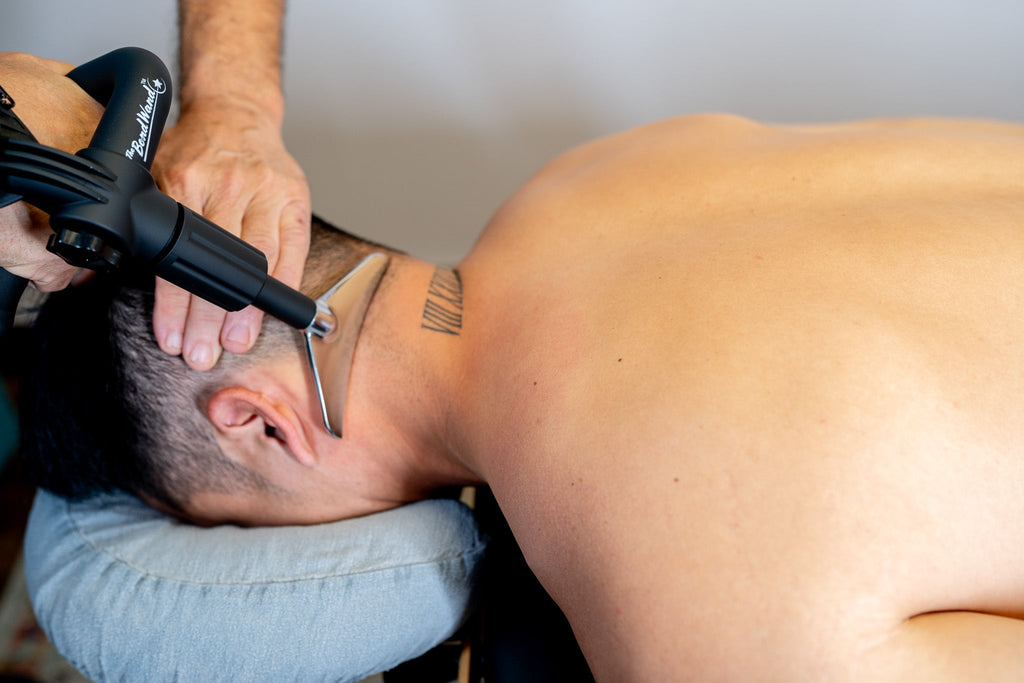Within the intricate framework of the human body, each one of the 600-plus muscles possesses the potential to develop myofascial trigger points. Trigger points are discerned as hyperirritable spots within a muscle, accompanied by a palpable nodule, where direct compression or pressure elicits pain and potentially refers it to other parts of the body.
In this blog post, we will take a deep dive into myofascial trigger points, exploring their mechanism, implications, and management techniques.
Understanding Myofascial Trigger Points: Beyond the Surface
Trigger points can stem from a myriad of factors, enveloping muscle overuse, injury, stress, and nerve irritation or damage. When muscles succumb to stress, they may form small knots or spasms, potentially restricting blood and oxygen flow to the muscle and thus initiating pain and inflammation.
In scenarios where the stress and trauma on a muscle are persistent and intensive, it might culminate in pronounced pain and dysfunction throughout the body, eventually evolving into myofascial pain syndrome and, in some cases, advancing to fibromyalgia.
Trigger points can cause a variety of problems, including:
- Localized pain
- Referred pain
- Muscle weakness
- Decreased range of motion
- Fatigue
- Headaches
- Migraines
- Temporomandibular joint disorder (TMJ)
- Fibromyalgia
Management Techniques for Trigger Points
There are a variety of treatment techniques that can be used to manage pain caused by trigger points. Some of the most common methods include:
- Direct pressure: Applying firm pressure to the trigger point can help to relax the muscles and reduce pain.
- Post-isometric relaxation (PIR): PIR is a technique that involves tensing and then relaxing the muscle containing the trigger point. This can help to release the muscle and reduce pain.
- Contract relax/antagonist contract (CRAC): CRAC is a technique that involves contracting and then relaxing the muscle containing the trigger point and its antagonist muscle. This can help to balance the muscles and reduce pain.
- Massage: Massage can help to relax the muscles and reduce pain.
- Stretching: Stretching can help to improve flexibility and reduce pain.
- Heat therapy: Heat therapy can help relax the muscles and reduce pain.
- Self-Management Tips for Trigger Points
There are several things you can do at home to manage trigger points as well:
Trigger Point Self Therapy with from The Bond Wand on Vimeo.
- Apply direct pressure to the trigger point. You can use your fingers, a tennis ball, or a foam roller to apply pressure. If using The Bond Wand, it is recommended attaching the ball tip head to target trigger points precisely.
- Perform post-isometric relaxation (PIR) exercises. Post-Isometric Relaxation (PIR) exercises represent a therapeutic approach, often utilized to enhance muscle flexibility and alleviate muscle tension. Incorporating principles of proprioceptive neuromuscular facilitation, PIR involves an initial gentle stretch of the muscle, followed by a period of isometric contraction and subsequent passive stretching. Aimed at leveraging autogenic inhibition—a temporary reduction in muscle contraction following a sustained contraction—the technique permits a deeper stretch and increased muscle length to be achieved post-contraction.
- Perform contract relax/antagonist contract (CRAC) exercises. Contract Relax/Antagonist Contract (CRAC) exercises are a type of stretching technique often used in physical therapy and exercise programs to increase flexibility and range of motion in muscles. This technique is rooted in the principles of proprioceptive neuromuscular facilitation (PNF) stretching, which involves both the stretching and contraction of the targeted muscle groups.
- Here's a simplified breakdown of how CRAC exercises typically work:
- Contract Phase: The muscle to be stretched is first contracted, often against resistance provided by a therapist or an inanimate object. This contraction is usually held for a specific period (commonly around 5-10 seconds), and the individual performs this phase with a substantial but submaximal effort (e.g., 50-75% of maximum effort).
- Relax Phase: Following the contraction, the muscle is briefly relaxed, typically for a few seconds, to prepare for the subsequent stretch.
- Antagonist Contract Phase: Next, the opposing muscle (antagonist) to the one initially contracted is engaged or contracted.
- Relax: Simultaneously, the muscle that was initially contracted (now relaxed) is gently stretched, often with assistance. This phase helps facilitate a deeper stretch in the targeted muscle by employing the antagonist muscle’s contraction.
- Get a massage. You can get a massage from a professional massage therapist, or perform a massage yourself with The Bond Wand. If using The Bond Wand, it is recommended to use The Roller Bar attachment for applying deep pressure on large areas and use on any broad, flat muscle.
- Stretch regularly. Stretching can help to improve flexibility and reduce pain.
- Use heat therapy. You can use a heating pad, hot water bottle, or hot shower to apply heat to the trigger point.
Myofascial trigger points are a common cause of chronic pain, but they can be effectively treated with a variety of techniques. In the event of persistent pain from trigger points, it is recommended to consult your healthcare professional for a thorough diagnosis and specific treatment recommendations.




Leave a comment: